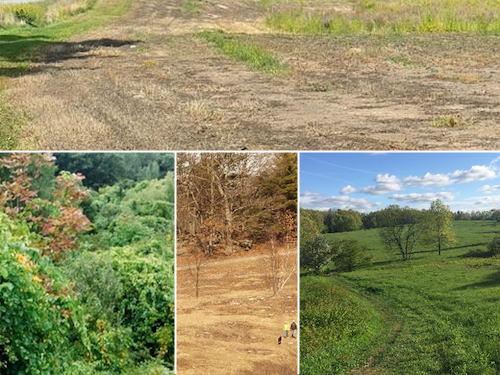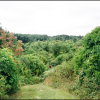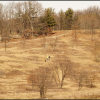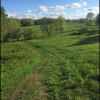Above: In defending their decision to kill plants along the roadside at Breakneck Hill, stewards provided photos exemplifying how a prior project with a similar approach had worked on the conservation land. (images cropped from contributed photos, top from Mary Hamaker and bottom from Stewardship Committee)
Earlier this month, I shared questions that a resident asked the Stewardship Committee to answer about a roadside area of Breakneck Hill Conservation Land. Now, I’m following up with the committee’s promised response.
As I noted in a prior post, in August, resident Mary Hamaker complained about a once “beautiful” wildflower meadow that was killed and remains brown and barren after repeated mowings. She wanted to know more about the decisions made, herbicides used, and the costs of the project that had yet to flower, three years after a Stewardship Committee sign labeled the area a “Roadside Meadow”.
Since I was among those copied on Hamaker’s letter, Stewardship copied me on their response.
The letter includes an attachment with detailed “context”. That begins with history of the land and Stewardship’s role, including how the committee has handled invasive plant issues at Breakneck Hill in the past.
The example photos they shared below were to demonstrate how the committee handled the dense bittersweet invasion that had taken over the land in 2003:
The document then describes the more recent decision to replace the roadside meadow that had been there with a new roadside meadow to “build on the success of the Beecology Research Garden”. Their intent is to plant a native plant meadow that is beneficial to pollinators.
The committee describes the old meadow as having been populated “with many invasive plants as well as non-native plants and grasses.” The list included plants that some people might see as attractive wildflowers: Queen Anne’s lace, Purple Loosestrife, Creeping Buttercup, Spotted Knotweed (which might be confused for Bachelor’s Buttons), Creeping Thistle, and Multiflora Rose. Each came with an explanation ranging from “aggressive” “noxious weed” to “invasive plants” that crowd/or block out valuable native plants.
To allow for the new meadow, the committee sought to kill off all weeds and invasive plants. Rather than sterilizing the soil or using what they considered to be too much herbicide for the location, they chose the approach of “Mowing and Harley raking”:
This approach involves repeatedly removing the vegetation and turning the soil over to allow new weeds/invasives to grow, and then turn it over again. Mowing before seeds set and turning the soil gets repeated through multiple growing seasons. Generally, some amount of herbicide will be needed to augment the process before sowing the meadow seeds. Although more time intensive, the Stewards chose this approach.
That project began in 2023. But, according to Stewardship, they ran into equipment issues that unexpectedly set them back by an entire season. They described the progress made since and the current status and future plans:
With final soil prep expected to be completed this fall, the Stewards are planning to sow the meadow seeds in late fall/winter of 2025. This required herbicide to reduce the persistent invasive plants. . .
We expect visible plants emerging, with some flowering, starting in Spring of 2026, and a fully established flowering native wildflower meadow by Spring of 2027. Once established, we expect the meadow to provide not only beauty but also an ongoing functional ecological habitat.
As Mr. Novick, our expert meadow consultant, has reminded the Stewards, a slow success is better than a fast failure.
Also attached to the letter was the committee’s answers to specific questions about the herbicide used, who approved it, and costs.
According to to that document, the total project costs, starting in 2023, through work in “Growing season 2026, is $32,850 (with $13,990 of that already spent). That doesn’t include “monitoring and management as needed” in future years.
You can read the committee’s full response here. (You can read more context on the questions about the situation here.)





